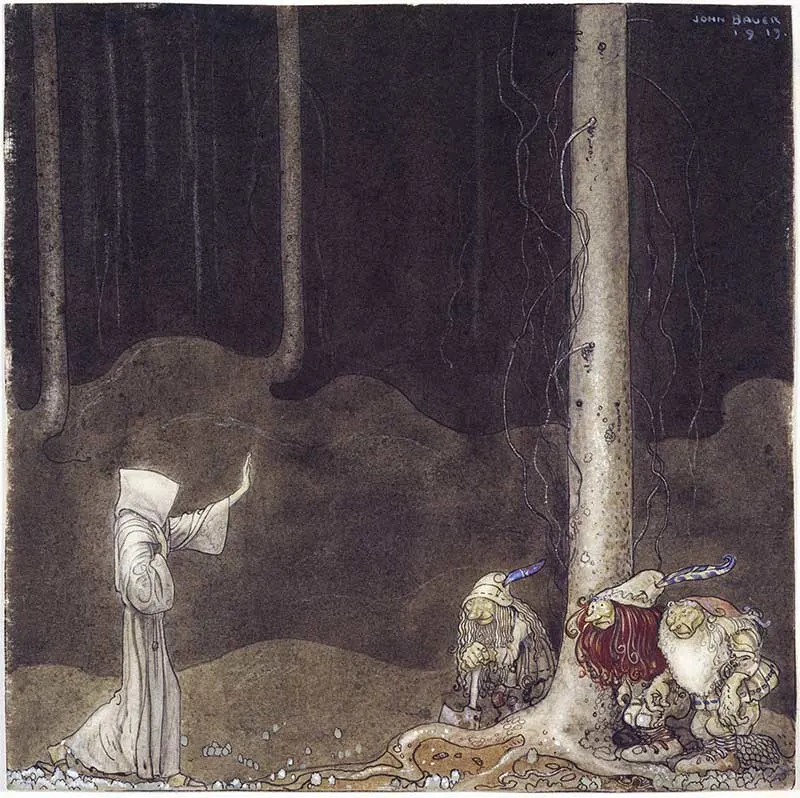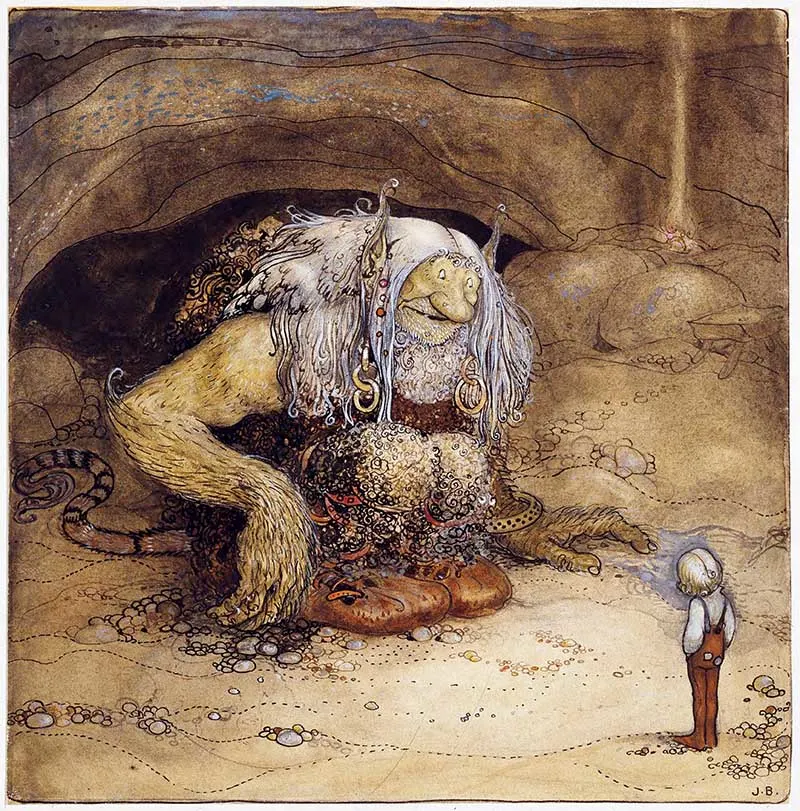Inside: Download iconic John Bauer artwork for free. Experience the magic of trolls, princesses, and enchanted forests in stunning detail with these 17 illustrations.
Delve into the enchanting realm created by John Albert Bauer. A renowned Swedish artist whose work breathes life into Sweden’s fairy tales and folklore. Bauer’s anthology of public domain artwork opens a gateway to a world where magical places, beings and mystical forests captivate the imagination.
The Artistic Journey of a Swedish Painter
From his early days at the Jönköping Technical School to his impactful contributions at the Royal Swedish Academy of Arts, Bauer’s journey was marked by dedication to capturing his love of Swedish folklore and Sami cultures.
His travels across Lapland, Germany, Italy, and the dense forests of southern Sweden enriched his artwork with a unique blend of traditional illustrations and romantic nationalistic style. The Italian Renaissance and Sami cultures particularly influenced Bauer.
A Legacy in Fairy Tale Illustrations
Bauer’s portfolio, a testament to his status as one of Sweden’s favourite artists, includes iconic pieces such as “Little Princess Tuvstarr”, gazing contemplatively into the water, showcasing his unparalleled talent in evoking narrative and emotion through art.
His portrayal of dark, mystical nature scenes and folklore characters, like the wise elk and the three trolls, captures the quintessential Scandinavian aesthetic, blending romantic mysticism with traditional storytelling.
Tragic End, Timeless Influence
The tragic demise of Bauer at the age of 36, along with his family in a shipwreck on Lake Vättern, casts a poignant shadow over his artistic legacy. Yet, his contributions to Swedish folklore and fairy tales continue to enchant and inspire, bridging past and present through his magical illustrations.
How To Download John Bauer’s Artwork
This curated collection of Bauer’s works is now freely accessible in the public domain. It includes notable pieces such as “Freyja” (1905), depicting the Norse goddess in an Art Nouveau style. And “The Princess and the Trolls” (1913), a vivid representation of “Bland Tomtar Och Troll” (Among Gnomes and Trolls), an anthology of Swedish folklore and fairy tales.
Available for download, these artworks offer a glimpse into Bauer’s fantastical visions. They allow you to bring a piece of Swedish heritage into your life.
Click on the title above Bauer’s work you want to download. A higher-resolution image will open in a new tab. You can then print or save this illustration.
Most of John Bauer’s art is watercolours of prints in monochrome or muted colours. The art and illustrations helped broaden an appreciation and understanding of Scandinavian mythology and landscape.
Print 1.Freyja – 1905
This stunning 1905 John Bauer art print is painted in an Art Nouveau style. It is a mythological painting of the Nordic goddess Freyja.
Freyja is probably the most important goddess in Norse mythology. Beautiful and many-functioned, she features heavily as a fertility goddess stemming from her place in the Vanir family of the gods.
2. The Princess and the Trolls 1913
This John Bauer art illustration of the Fairy Princess and two trolls is from the anthology.
This particular illustration was for the story by Helena Nyblom The Changlings, (Bortbytingarana).
The story is about the troll father who the little Princess Bianca Maria so takes that he swaps her with his troll baby. The children grow up with their new families but never fit in. By the time they are due to get married, their situation becomes untenable. They both flee on their wedding day to their original homes, and all is put right.
3. A Knight Rides On
The blues in this later (1915) painting of John Bauer are stunning.
4.Lena Dances With The Knight
Another colourful John Bauer illustration from the 1915 edition of the anthology Bland tomtar och troll (Among Gnomes and Trolls).
5. Brother St. Martin And The Three Trolls
“Broder Martin” is a tale by Emil Eliasson and published in the 1913 edition of Bland Tomtar och troll.
6. John Bauer Art Print – The Kings Cup
The translated text accompanying this John Bauer art print is, ” He led the horse by the bridle and in this way they traveled through the woods ”
The illustration is from the Swedish folktale ” Konungens bägare” (The Kings Cup), published in 1908 and written by Sophie Linge.
7. John Bauer Illustration – Poor little Basse! 1912
This John Bauer artwork is from the Swedish folktale “Oskuldens Vandring” (The Walk of The Virgin) by Helena Nyblom.
8. 1912 The Boy Who Was Never Afraid
A Swedish folktale art print from “Pojken som aldrig var rädd” (The boy who was never afraid) by Alfred Smedberg 1912.
This particular drawing is titled “Nej, sicken liten puttefnasker! Ropade trollet” (No, what little crap! Shouted the troll).
9. John Baur Art – Tuvstarr by the Water – 1913
The caption for this folktale illustration is “Ännu sitter Tuvstarr kvar och ser ner i vattnet” (Yet Tuvstarr is still sitting looking down into the water).
This painting is from the tale “Sagan om äldtjuren Skutt och lilla prinsessan Tuvstarr” (The story of the bull Skutt and little princess Tuvstarr).
The tale was written by Helge Kjellin and published in the 1913 edition of Bland Tomtar och Troll.
10. Humpe in the woods – 1913
This illustration is from the tale “Trollsonen som hade solögon och vart skogsman”, (The troll son who had sunglasses and every woodsman).
Written by Vilhälm Nordin and published in the 1912 edition of Bland tomtar och troll (Among gnomes and trolls).
11. Nilas offer, Julbocken (II)
I don’t know much about this particular Bauer drawing except that it is titled “Nilas offer, Julbocken (II)” (Nila’s victim, Christmas goat).
12. Christmas Goat – 1912
Again, I don’t have much information about this particular Bauer illustration except that it is titled “Julbock” (Christmas goat).
Print 13 One Eyed Troll
Print 14: The Sword and The Lindworm
Illustration by John Bauer depicting a young man with a sword fighting a snake. Published in the storybook “Guldslottet, Barnens julbok No. 13” for the story “The Maiden in Rosiga Molnens Borg” by Harald Östenson, 1911.
Lindworms are mythical serpent-like creatures from European folklore, particularly Norse and Germanic traditions. They are often depicted as large dragons with no wings and sometimes no legs, resembling giant snakes.
In stories, lindworms are known for their venomous bite, strength, and the terror they cause. They frequently appear as guardians of treasures or destructive forces, embodying challenges to be overcome by heroes through bravery and cunning.
Print 16: Crown of Gold
Then the prince put a crown of gold on her head.
Illustration from the story “The Tale of Day and Day and the Flying Troll on Skyberget” de Harald Östenson, realized by John Bauer for “Among Gnomes and Trolls”
Print 17: Christmas Illustration
A John Bauer illustration for an 1911 Swedish Christmas magazine cover.
Other Related Posts
Gnomes are also very popular in Scandinavian folklore.
Dragons are a popular fairytale theme, here you’ll find a few fairytale images of dragons. You might also love these beautiful flower fairy illustrations.
If you liked these fabulous John Bauer illustrations of Scandinavian folk tales, you might like some of these other vintage illustrations:
- Scandinavian Christmas Cards
- Vintage Circus Posters
- Japanese Travel Posters
- Vintage Zodiac Sign Pictures
If you fancy, you can Buy Me A Coffee Here.


















cecelia
Thursday 1st of December 2022
These stir the wonder of childhood. I love them. Thank you so much for sharing.
claire
Friday 2nd of December 2022
Thank you, they are beautifully illustrated stories.
Mary
Thursday 1st of December 2022
Really enjoyed this art and the stories today, thank you.
claire
Friday 2nd of December 2022
Thank you, that is lovely to hear.